The Holy Week That "Is"
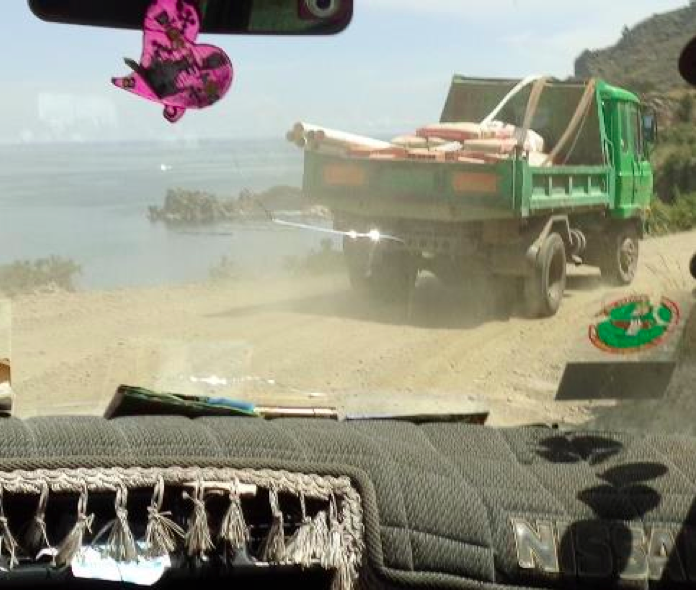 Bricks, Mortar and Sweat
Bricks, Mortar and Sweat
Remember a little over two weeks ago we and leaders of the Chañi church came to an agreement to build a kitchen and latrines that would share a wall and septic system, and thereby cost the church and the mission less money?
Materials were purchased (see right, en route to project site) and members immediately started working on the building. Earlier this week Jeff helped lay brick. Holy Thursday, he and a gang of volunteers trenched for and laid out the septic system. Look how much work’s been done! The church folks – and we – are mighty proud!
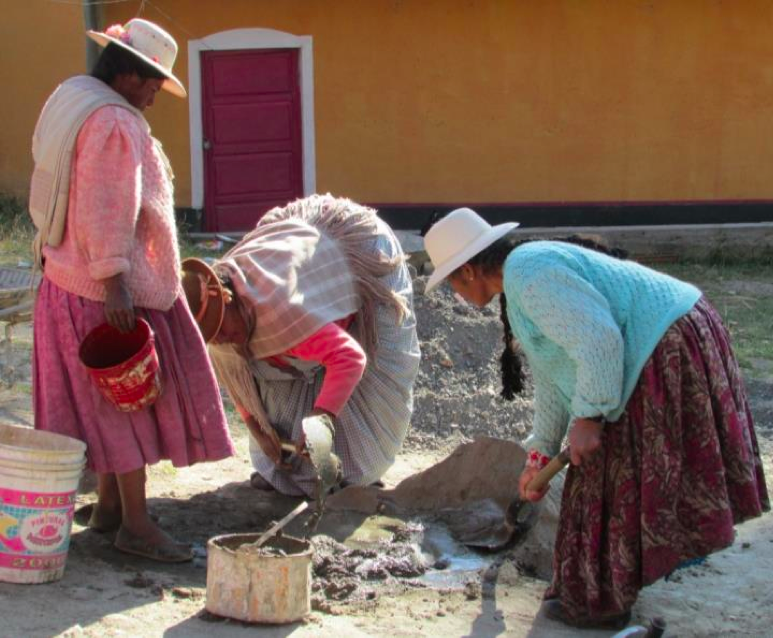

During a break a Chañi man observed it was a good thing the latrines are roomy "because all the women are at least a meter wide." One of his buddies feebly tried to save him by saying, "No, they’re only 90 centimeters wide." The women, who do the bulk of all the hard work and also run the church, turned pointy looks at the men. The would-be rescuer quickly added "anyways, it’s all pollera!" (polleras are the wide, horizontally pleated skirts worn with at least four horizontally pleated, gathered underskirts; when I wear one, I have to squish through doorways.) Everyone laughed.

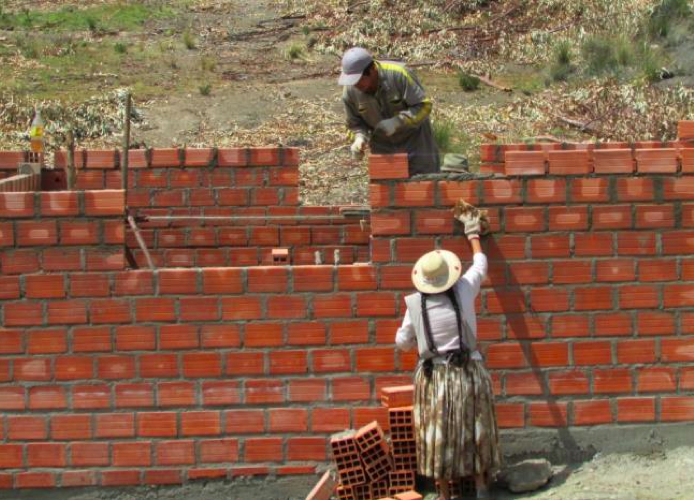
The Holy Week That Is
 This year, Holy Week in Copacabana is especially sacred. You may recall the Holy Week That Wasn’t newsletter of last year. Just before Holy Week, the town’s patron saint, the Dark Virgin of the Lake, was robbed of her golden crown and crescent moon, and all her adornments of precious gem stones. Also, Holy Week 2013 never really happened in Copa because residents of a nearby village held our town under siege for nearly three weeks protesting the location of a proposed bridge linking the Copa peninsula and La Paz. Blockades barred the usual 30,000 to 40,000 Easter pilgrims from reaching Copacabana. Copa’s food supplies, economy, and mood flattened to nearly zero.
This year, Holy Week in Copacabana is especially sacred. You may recall the Holy Week That Wasn’t newsletter of last year. Just before Holy Week, the town’s patron saint, the Dark Virgin of the Lake, was robbed of her golden crown and crescent moon, and all her adornments of precious gem stones. Also, Holy Week 2013 never really happened in Copa because residents of a nearby village held our town under siege for nearly three weeks protesting the location of a proposed bridge linking the Copa peninsula and La Paz. Blockades barred the usual 30,000 to 40,000 Easter pilgrims from reaching Copacabana. Copa’s food supplies, economy, and mood flattened to nearly zero.
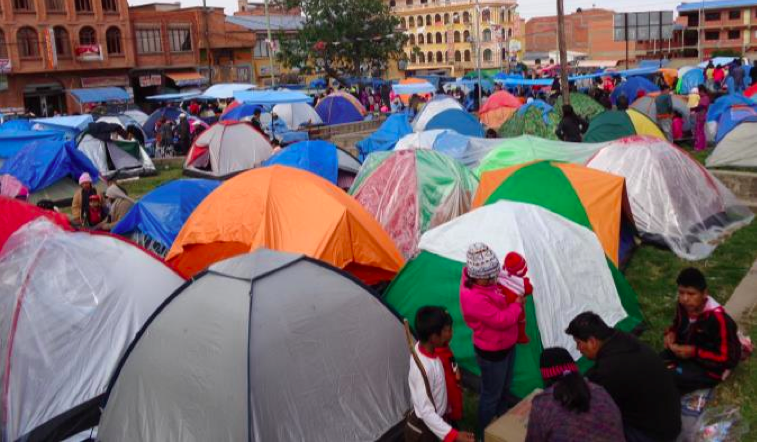
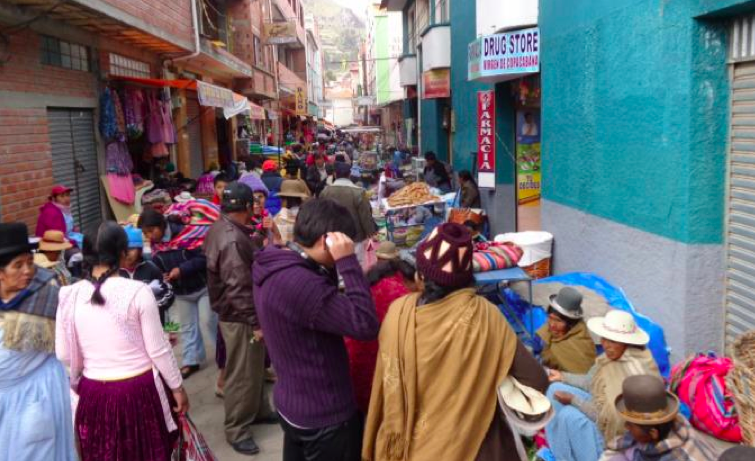
 This year we’ve rebounded, grandly and joyously. The mayor ordered every zona president to organize a mandatory work day to clean up the streets and green spaces so Copa will be tidy and pretty for all the anticipated visitors. Our work day started at 6 a.m. Monday. So many neighbors showed up we were done just after 7 a.m.
This year we’ve rebounded, grandly and joyously. The mayor ordered every zona president to organize a mandatory work day to clean up the streets and green spaces so Copa will be tidy and pretty for all the anticipated visitors. Our work day started at 6 a.m. Monday. So many neighbors showed up we were done just after 7 a.m.
To kick off Holy Week, zona presidents also planned a formal procession through town. Every neighborhood prepared an altar placed in the middle of the town’s two main streets. Ornate statues of the Virgin and huge floral bouquets adorned the altars. In the Virgin’s honor, residents decorated the streets with vast mosaics made of flower petals.
Learning to Make Jumint’as
Making and eating jumint’as (“hoo MEEN tahz” in Aymara, hoo MEN tahz” in Spanish), a tamale-like, slightly sweet corn snack, is a treasured local tradition throughout Holy Week. Generations of families gather, especially on Holy Thursday, to make hundreds of them. Recall, in the Southern Hemisphere, Easter aligns with harvest time. Here, that means a bounty of fresh corn.
Jeff and I spent that day in Chañi, expecting to work on the new building. Instead, Justina and Isabela told me I’d be helping them make jumint’as, for which they are famous.
The mound of choclo (large-kernel, white corn) harvested that morning was colossal. I was glad some of the men helped us husk and shuck most of it before they headed off to work on the kitchen and latrines. Traditionally, the corn would have been ground by hand with a large, heavy grinding stone. But we were aiming to make hundreds of jumint’as, so the three of us took turns cranking a manual meat grinder, while Isabela’s elderly parents rocked the stone grinder.
Here’s the recipe, trimmed down to family size:
- 2 pounds fresh white corn shucked off the cob; large, tender, husks carefully removed and reserved
- 1 small carrot, coarsely chopped
- 1⁄2 tsp. cinnamon
- 1⁄4 tsp. ground anise seed
- 2 – 3 Tbls. white sugar
- ~ 1⁄4 cup vegetable oil
- salt
- 4 to 6 oz. farmers cheese (or other firm, salty cheese) sliced into 1.5 x 2.5 x 1/8th-inch planks
- Remove corn kernels from cobs. Grind corn and carrots in a meat grinder (a food processor or blender would probably do, but try to preserve a wet, oatmeal-like texture). Add and stir in remaining ingredients except cheese. Adjust seasonings as desired.
- Fold a large husk in half, inner side facing up. Spoon about 1⁄4 cup of the batter onto the husk in an even, triangular shape. Top with a slice of cheese. Fold other half of the husk over the batter, smooth out air pockets and tuck in long edges to lightly seal.
- Bake about 30 minutes in a 450-degree oven until batter is no longer steaming, and is set but not dry, and husks are browned.
We baked our jumint'as in a hand-made, outdoor, wood-burning oven, between layers of hot stones, and branches from fennel and koa plants (koa is a scrubby Andean herb with a minty-menthol flavor). This is the very best way to bake jumint'as. As the sun and temps dropped at the end of nine hours of hard work making them, I was grateful to eat two jumint’as hot off the stones.
Happy Easter, Friends.
May the spirit of Resurrection lift you up and fly you forward.
With Love and Gratitude, Deb and Jeff
- Debbie Rissing's blog
- Log in to post comments
God, as known to us in Jesus Christ, welcomes all.
We welcome people of any race, national origin, ethnicity, gender, sexual orientation, age, social or economic status, employment status, or life situation; including people with physical or mental illness or disability.
We practice loving acceptance of each person and respectful discussion
 of our differences.
of our differences.
Affiliated to Reconciling Ministries Network
Recent News
Sunday Worship Service - July 30 at 10:00 am
July 30, 2023 - 9:51am
Sunday Worship Service - July 23 at 10:00 am
July 23, 2023 - 9:48am
Sunday Worship Service - July 16 at 10:00 am
July 16, 2023 - 10:17am
Vacation Bible School
July 14, 2023 - 10:10pm
Sunday Worship Service - July 9 at 10:00 am
July 9, 2023 - 9:53am










